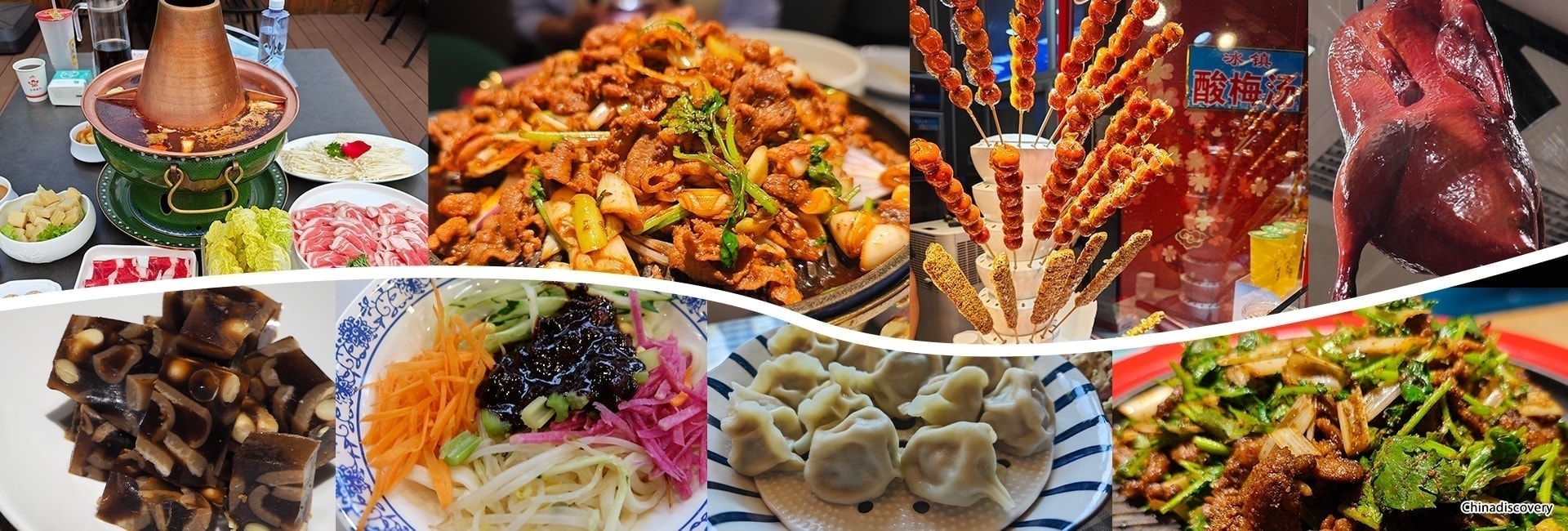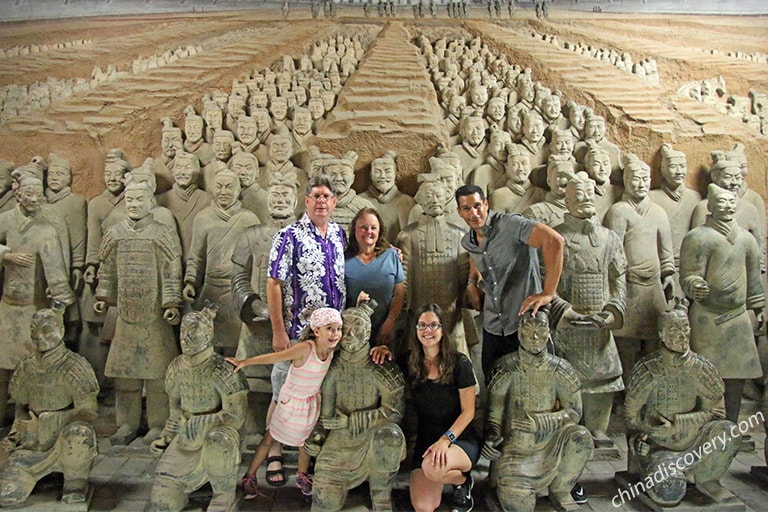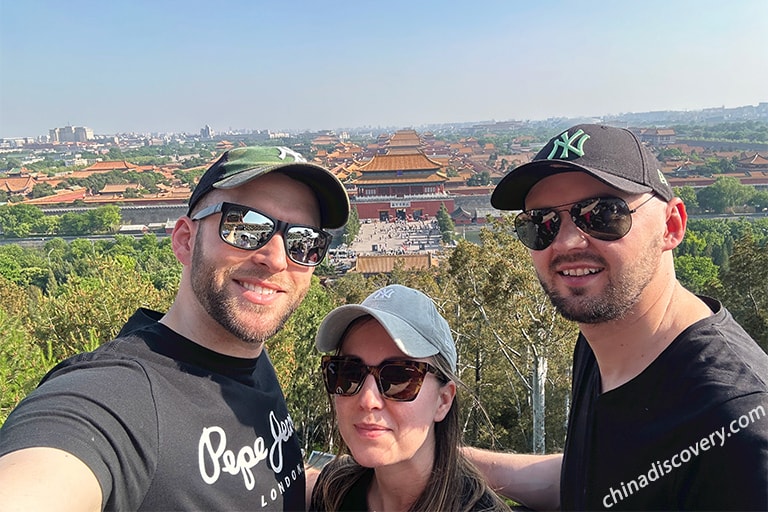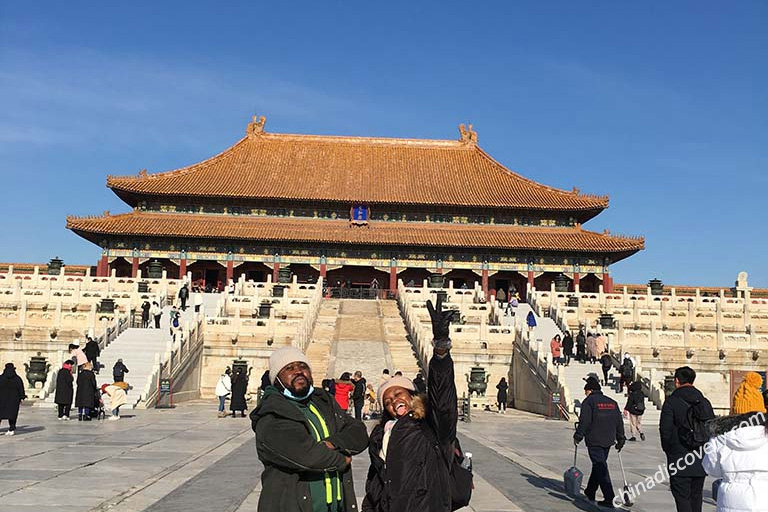Popular Beijing Chinese Food, Snacks & Cuisines | Beijing Food Tours 2025/2026
Chinese cuisine is renowned all over the world for its appearance, aroma, and flavour. As the capital of China for over 800 years, Beijing developed its own unique cuisine incorporating the best features of different regional styles and reached its present form in Qing Dynasty (1644 AD - 1911 AD). Among the most famous dishes, there are Court Cuisine, Beijing duck, Halal snack, vegetarian dessert, street food, etc. Here, we have the most representative Beijing Chinese food and snacks listed for your food hunting in Beijing!
Table of Contents
- ① Peking Roast Duck
- ② Instant-boiled Mutton
- ③ Chinese Imperial Cuisine
- ④ Jiaozi - Dumplings
- ⑤ Zhajiangmian - Noodles with Soybean Paste
- ⑥ Fermented Mung Bean Juice & Fried Chinese Doughnut
- ⑦ Dalianhuoshao - Fried Wheaten Pancake with Fillings
- ⑧ Luzhuhuoshao - Wheaten Cake Boiled in Meat Broth
- ⑨ Chaoganer - Fried Liver
- ⑩ Baodu - Boiled Lamb Tripe
- ⑪ Tanghulu - Sugar Coated Hawthorns on a Stick
- ⑫ Wandouhuang - Pea Flour Cake
- ⑬ Lvdagun - Rolling Donkey
- ⑭ Aiwowo - Glutinous rice ball
- ⑮ Sachima - Rice Krispies Treats
- ⑯ Nailao - Beijing Yogurt
- ⑰ Recommended Beijing Food Street
• Chinese:北京烤鸭 Pinyin: běi jīng kǎo yā
• Type: Roasted, Pancake, Beijing Specialty, Meat
• Recommended Restaurant: Dadong Roast Duck Restaurant 大董烤鸭店 (Location: Five Floors of Jinbaohui, 88 Jinbao Street, Dongcheng District, Beijing 北京市东城区金宝街88号金宝汇5层)
Beijing Roast duck (Peking duck) is a world-renowned dish, originated in the Northern and Southern Dynasties of China (386 AD - 589 AD) and was a court food at that time. The duck is carefully selected young and tender peking duck. Brushed with honey and roasted with charcoal until turning brownish in a closed or hung oven, the roast duck is fat but not greasy, crisp outside and juicy inside. Then the roasted duck will be sliced into small pieces with few minutes and placed orderly in a plate, served with shredded scallion, cucumber and sweet bean sauce, and light pancakes. You can just eat the duck meat or try to make a duck roll with those pancakes, and that's the authentic Chinese way to enjoy the cuisine. >>Top Recommended Peking Duck Restaurants
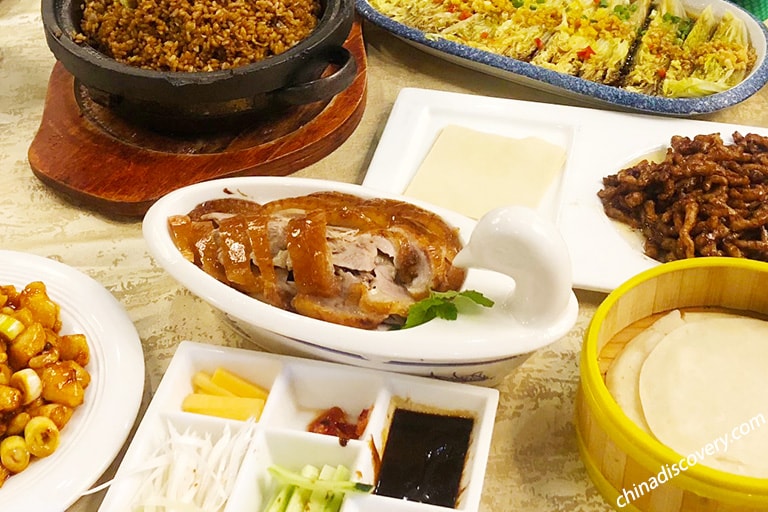
Peking Roast Duck (Beijingkaoya 北京烤鸭)
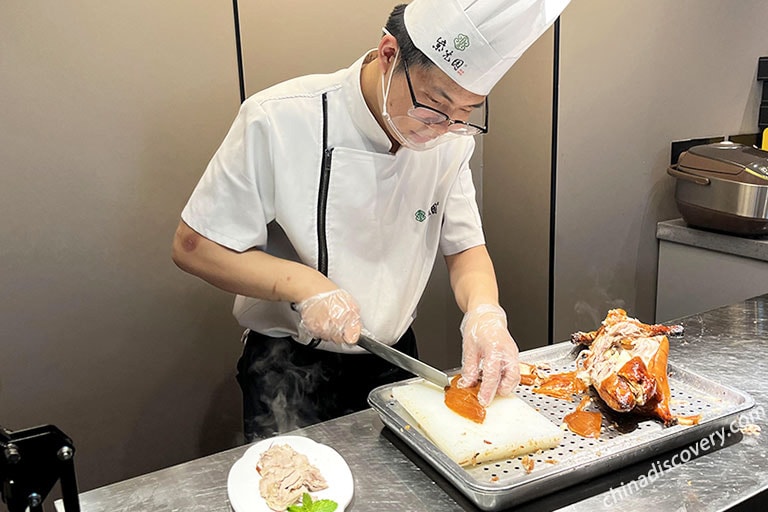
Peking Roast Duck (Beijingkaoya 北京烤鸭)
• Chinese:涮羊肉 Pinyin: shuàn yáng ròu
• Type: Hot Pot, Halal Food, Boiled, Beijing Specialty, Meat
• Recommended Restaurant: Donglaishun Restaurant 东来顺 (Location: First Floor of Qinian Hotel, 91 Tiantan Road, Dongcheng District, Beijing 北京市东城区天坛路91号祈年饭店一层)
Instant-boiled mutton, also known as Mongolian Hot Pot is a traditional Beijing halal dish, which can be dated back to the Yuan Dynasty (1271 AD - 1368 AD). Eating the instant-boiled mutton in winter is a great enjoyment in the ancient time, but now, the mutton hot pot has been served all year round. A copper stove with boiling water and burning coals underneath it will be placed in the middle of the table, served with mainly mutton slices and other dishes such as tofu, cabbages, bean sprouts, mushrooms and noodles. Eaters can pick up the mutton slice with chopsticks and put into the boiling water for seconds until its color changes, and then enjoy the mutton with some dipping sauce which is a mixture of sesame oil, chili oil, green onions, etc.
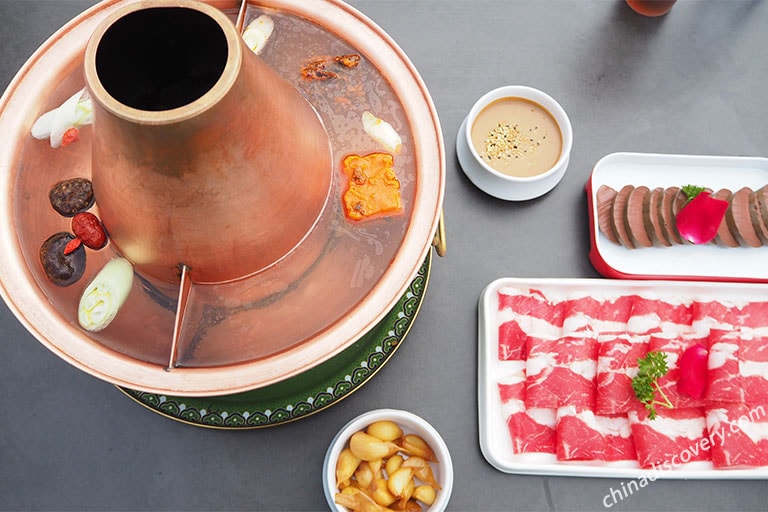
Beijing Hot Pot (Shuanyangrou 涮羊肉)
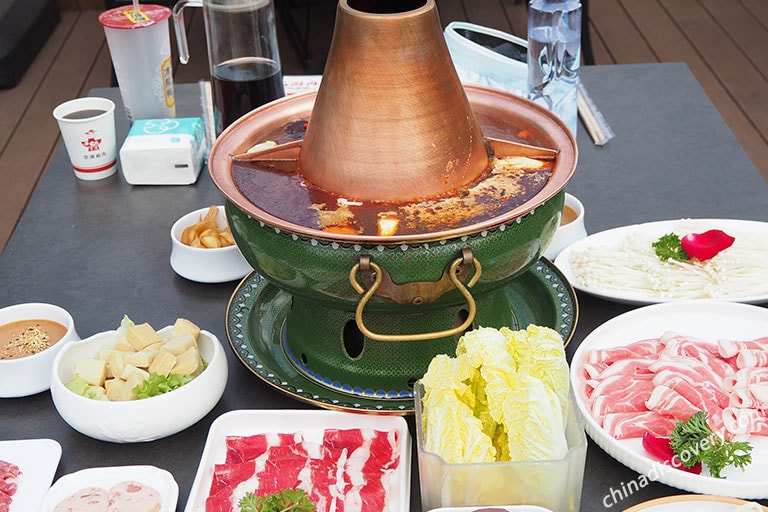
Instant-boiled Mutton Hot Pot (Shuanyangrou 涮羊肉)
• Chinese:宫廷菜 Pinyin: gōng tíng cài
• Type: Multiple Dishes, Royal Food, Beijing Specialty, Meat & Vegetables
• Recommended Restaurant: Fangshan Restaurant (Imitation Imperial) 仿膳饭庄 (Location: Beihai Park, No. 1 Wenjin Street, Xicheng District, Beijing 北京市西城区文津街1号北海公园内)
Chinese Imperial Cuisine, as the name suggests, consists of dishes once prepared exclusively for the imperial family. Every Dynasty in Chinese had an "imperial kitchen" to prepare meals for the emperor and his consorts. The dishes were not only meticulously prepared, but also included rare and expensive food stuffs, such as bear's paws, birds' nests, venison, sea cucumbers, duck webs and other delicacies of land and sea. The court cuisine of today is based on the dishes prepared by the Qing imperial kitchens but further developed ever since.
• Chinese:北京水饺 Pinyin: běi jīng shuǐ jiǎo
• Type: Snack, Boiled, Meat & Vegetables
• Recommended Restaurant: Baoyuan Dumpling Restaurant 宝源饺子屋 (Location: Building 6, Maizidian Street, Chaoyang District, Beijing 北京朝阳区麦子店街6号楼)
Dumplings are indispensable to the dinner table on Chinese New Year's Eve. In most parts of northern China, dumplings are mainly handmade with chewy wheat-flour skin and warm, juicy fillings. Dumpling stuffing is usually a mixture of meat and vegetables, such as pork, beef, prawn, sweet corn, yam, mushroom, and cabbage, but there are also dumpling contents with only vegetables (mushrooms, carrots, cabbage, etc). The authentic cooking method is usually boiling instead of frying. A hot bowl of dumpling soup in winter, your beloved family around you, dumplings in China is beyond food itself, but a culture.
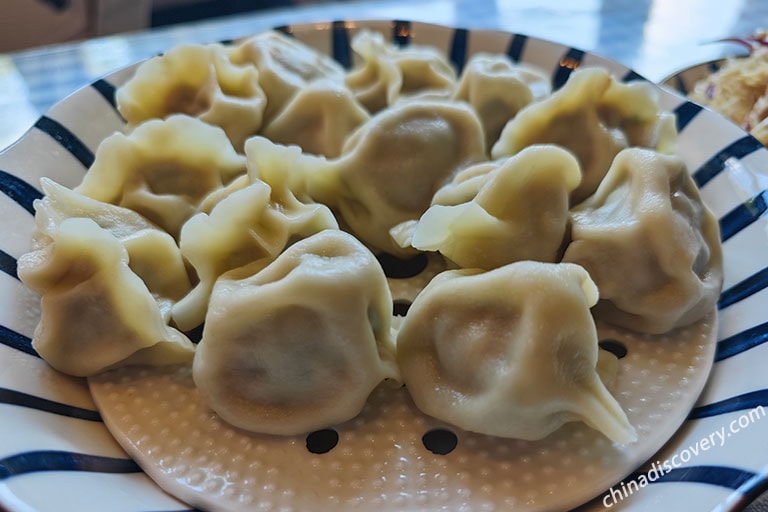
Boiled Dumplings (Jiaozi 北京水饺)
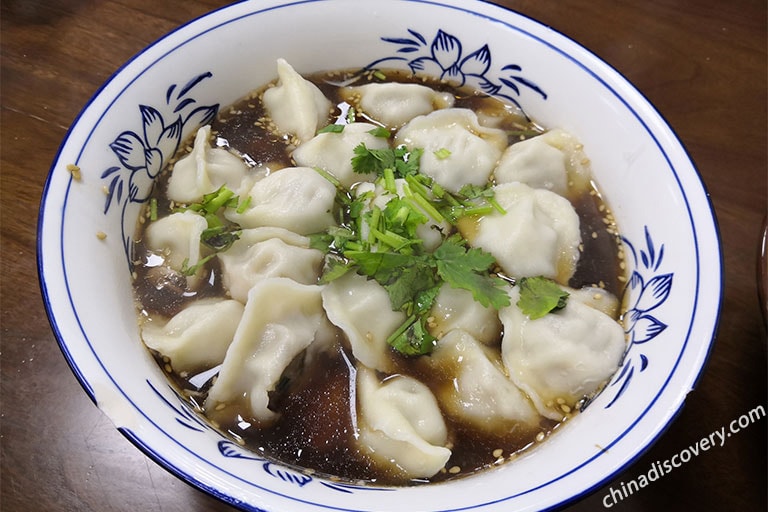
Dumpling Soup (Jiaozi 北京水饺)
Chinese:北京炸酱面 Pinyin: běi jīng zhà jiàng miàn
Type: Snack, Boiled, Meat & Vegetables
Recommended Restaurant: Fangzhuanchang Zhajiangmian方砖厂69号炸酱面 (Location: No. 1 Hutong, Fangzhuangchang, Dongcheng District, Beijing 北京市东城区方砖厂胡同1号)
As an iconic northern Chinese food, Zhajiangmian originate from Shandong province. Zhajiang means "fired sauce", which is a kind of black paste made by stir-fired pork and salty soybean. Besides the black Zhajiang, sliced fresh vegetables, such as cucumber and radish will be alongside of it, atop the hand-pulled wheat noodles. Zhajiangmian is a classic Beijing dish, mainly for breakfast and dinner and it is loved not only by the Chinese people but also Korean, known as Jajangmyeon.
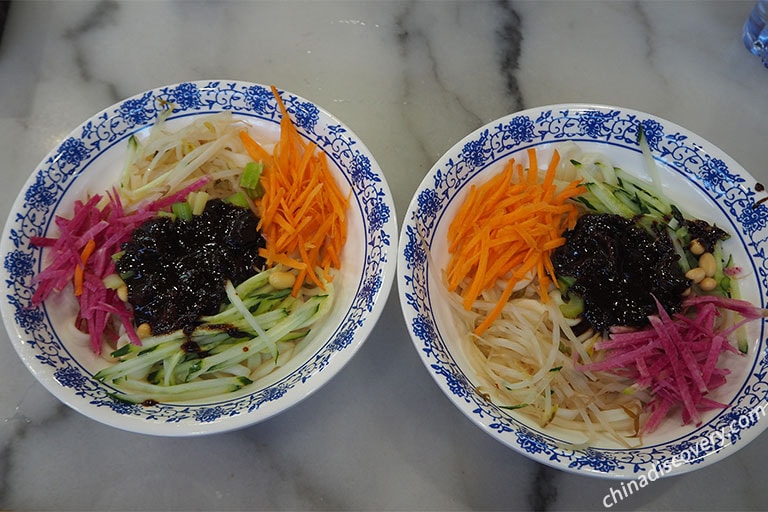
Noodles with Soybean Paste (Zhajiangmian 北京炸酱面)
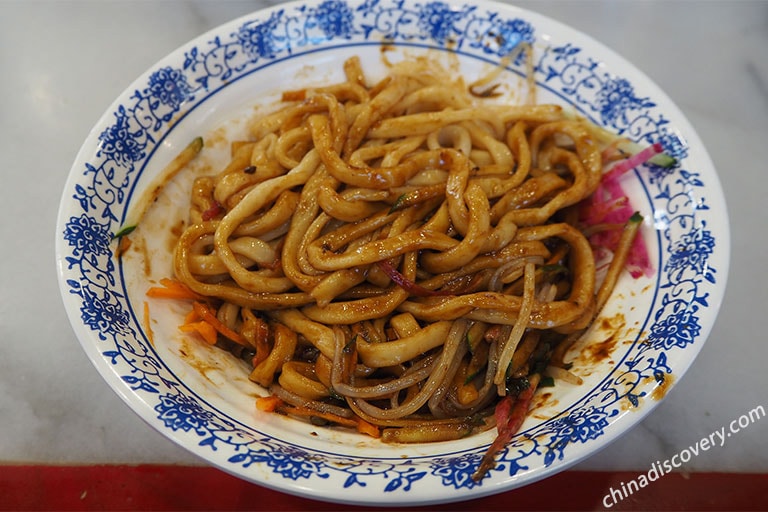
Noodles with Soybean Paste (Zhajiangmian 北京炸酱面)
• Chinese:焦圈 & 豆汁 Pinyin: jiāo quān & dòu zhī
• Type: Snack, Deep-fired & Fermented, Drink
• Recommended Restaurant: Laociqikou Restaurant老磁器口豆汁店 (Location: No.5 Commercial Building, Temple of Heaven North, Dongcheng District, Beijing 北京市东城区天坛北里5号商业楼)
Jianquan and douzhi always serve together as breakfast for local Beijingers. Jiaoquan, crispy and crunchy, is golden in color, like a bracelet in shape, a Chinese version doughnut. While douzhi is a special Beijing drink made by fermented soybeans. It looks like soy milk, but with completely different flavor. It is a little bit sour, smells like egg. Some people like it so much, while others can not bear its flavor.
• Chinese:褡裢火烧 Pinyin: dā lián huǒ shāo
• Type: Snack, Fried, Meat & Vegetables
• Recommended Restaurant: Furongju Restaurant福荣居褡裢火烧 (Location: 143 Dongsi North Street, Dongcheng District, Beijing 北京市东城区东四北大街143号)
It is a common traditional food in Beijing since the Qing Dynasty (1644 AD - 1911 AD). When making, the pancake with meat and vegetable fillings are folded on both sides, and the other two sides are not sealed. Fried in a pan until it turns golden brown, the pancake is long strip shaped and served while hot. It tastes similar to the fried dumplings, but more juicy. The local Beijingers often eat the fried pancake with hot and sour soup, which is fragrant, sour and spicy with an amazing special aftertaste.
• Chinese:卤煮火烧 Pinyin: lǔ zhǔ huǒ shāo
• Type: Beijing Snack, Viscera, Boiled, Meat & Vegetables
• Recommended Restaurant: Chen's Luzhu 陈记卤煮小肠 (Location: No. 82, No. 2 Langfang, Xicheng District, Beijing 北京市西城区廊房二条82号)
Luzhuhuoshao is a kind of meat broth with pork lung, intestines, wheaten cakes and tofu slices, boiled with garlic juice, soybean curd juice for hours. The meat is well-cooked, and the lung and intestines taste chewy, and it gradually became popular among local Beijingers. It is said that the pig viscera began to be put into the broth to replace the meat in the Qing Dynasty (1644 AD - 1911 AD), because the pork's price is a lot higher. Over time, luzhuhuoshao, the traditional Beijing cuisine was created. Do not be scared of its ingredients, get to experience it with courage once in your lifetime!
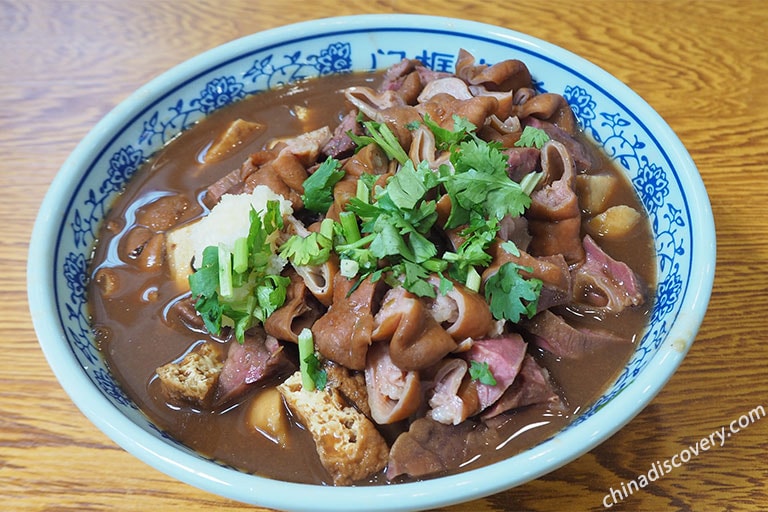
Wheaten Cake Boiled in Meat Broth (Luzhuhuoshao 卤煮火烧)
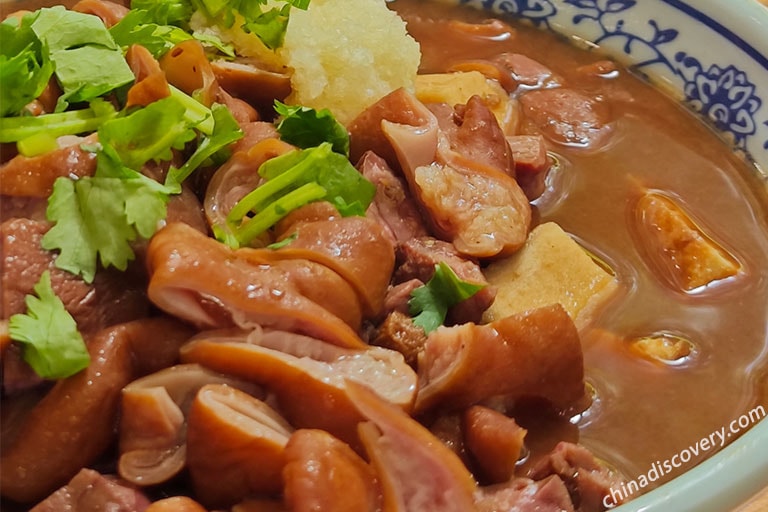
Wheaten Cake Boiled in Meat Broth (Luzhuhuoshao 卤煮火烧)
• Chinese:炒肝儿 Pinyin: chǎo gān ér
• Type: Beijing Snack, Viscera, Boiled, Meat & Vegetables
• Recommended Restaurant: Zhao's Chaoganer赵记炒肝 (Location: 8 Shazikou Road, Dongcheng District, Beijing 北京市东城区沙子口路8号)
Fried liver is one of the famous traditional food in Beijing. Though it is called fried liver, the main ingredient is intestines and and pork liver is only 1/3 of it. The first step is to wash the pig's viscera until the smell has gone. After boiling, the intestines and pork liver are cooked thoroughly with garlic, black soybean sauce, covered with a lid, so the color is brown. Therefore, the so-called fried liver is not fried, but boiled. However, because of the starch in the soup, it needs to be stirred continuously, so it has the feeling of "fried".
• Chinese:爆肚 Pinyin: bào dù
• Type: Beijing Snack, Viscera, Halal Food
• Recommended Restaurant: Feng's Baodu爆肚冯 (Location: No. 56, 2 corridors, Xicheng District, Beijing 北京市西城区廊房二条56号)
Boiled lamb tripe has been a popular Muslim food in Beijing since the Qing dynasty (1644 AD - 1911 AD). Put the sliced halal lamb tripe into boiling water and quickly remove it to the cold water. It's fresh, crisp, tender and chewy. The cooking skill requires rich experience to control the boiling time and the fire. The boiled lamb tripe always comes with the dipping sauce. The ingredients of the sauce are: coriander, onion, sesame sauce, soybean curd, chili oil, garlic paste, shrimp oil, leek flower, soy sauce, vinegar, and the same ingredients for eating instant boiled mutton.
• Chinese:糖葫芦 Pinyin: táng hú lú
• Type: Dessert, Fruit, Vegetarian Friendly, Packaged
• Recommended Restaurant: Daoxiangchun 稻香村 (Location: 59 Qianmen Street, Dongcheng District, Beijing 北京市东城区前门大街59号)
Tanghulu is a kind of traditional Chinese dessert, quite popular among kids and known by almost every Chinese. It is a candied fruit skewer in about 20 cm long. Though there are many kinds of sugar coated fruits, including cherry tomatoes, pineapples, apples, oranges, strawberries, bananas, and so on, the most authentic tanghulu is made by the fresh hawthorns, Chinese haw, or Shanzha (山楂) in Mandarin. The seeds of the hawthorn are emptied before being skewered and candied. It tastes sour and sweet,and often appears at food streets and night markets.
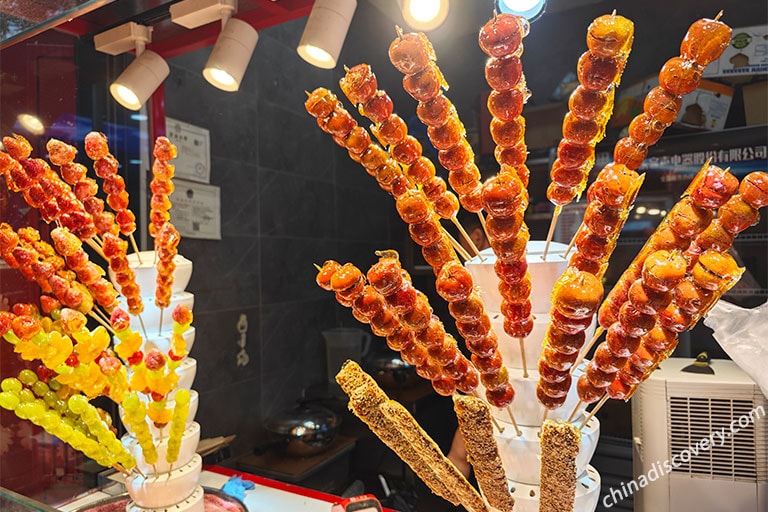
Sugar Coated Hawthorns (Tanghulu 糖葫芦)
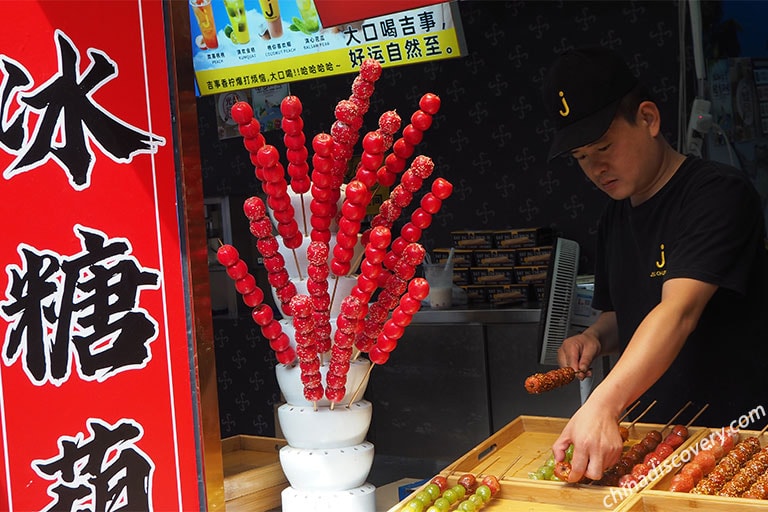
Sugar Coated Fruits
• Chinese:豌豆黄 Pinyin: wān dòu huáng
• Type: Dessert, Vegetarian Friendly, Packaged
• Recommended Restaurant: Bai's Halal Snack 清真白记小吃 (Location: Muslim Supermarket 1st Floor, Niu Street, No. 5 Niu Street, Xicheng District, Beijing 北京市西城区牛街5号牛街清真超市1楼)
Pea Flour is a seasonal delicacy in Beijing in spring and summer. Originally a folk snack, it was introduced to the court. Pea Flour Cake of the Qing Dynasty (1644 AD - 1911 AD), using the good white pea as raw material, is in light yellow, and tastes sweet and refreshing. Pea Flour Cake is famous for wining the preference of Empress Cixi. Grinding, peeling, washing, boiling, stir-frying, coagulating and cutting peas into pieces, there are many steps of making this delicious dessert. Sometimes, the red dried dates are added as cake fillings. There are two kinds of pea flour cakes. One is the court snack made by imitating traditional cooking process. The other is the rougher pea flour cakes sold by street vendors. Their prices and flavors are quite different.
• Chinese:驴打滚 Pinyin: lǘ dǎ gǔn
• Type: Dessert, Vegetarian Friendly, Packaged
• Recommended Restaurant: Bai's Halal Snack 清真白记小吃 (Location: Muslim Supermarket 1st Floor, Niu Street, No. 5 Niu Street, Xicheng District, Beijing 北京市西城区牛街5号牛街清真超市1楼)
The rolling donkey, also known as bean pastry, is one of the famous traditional snacks in Beijing. The finished dessert is in red, white and yellow. It is white glutinous rice rolled with red bean paste, because the final step is to wrap it with yellow soybean powder, like donkeys rolling in the dust, so it is named rolling donkey. It tastes and sweet and soft, which is loved by Beijingers for centuries.
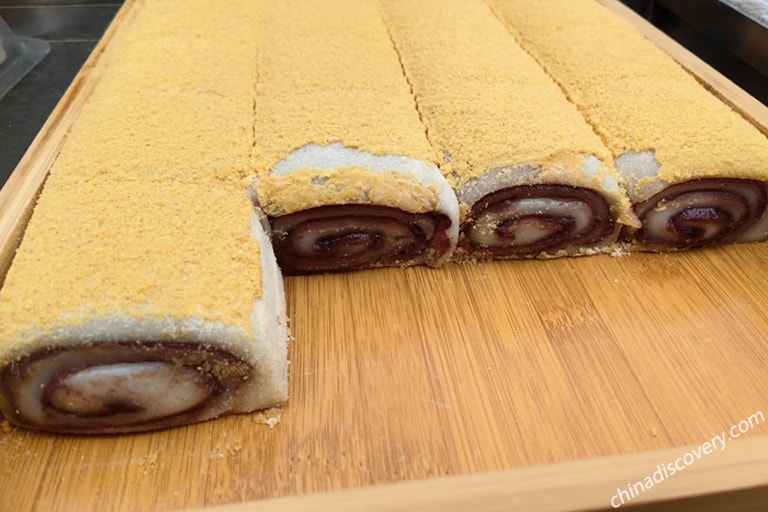
Rolling Donkey (Lvdagun 驴打滚)
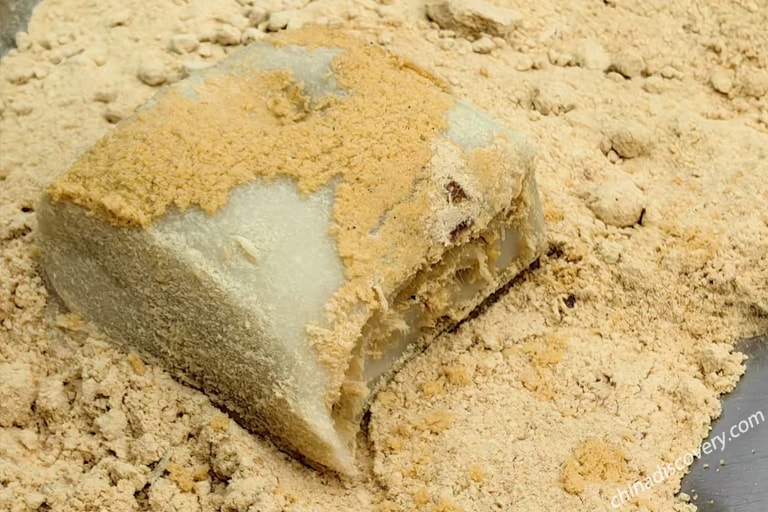
Lvdagun Close-up
• Chinese:艾窝窝 Pinyin: ài wō wō
• Type: Dessert, Vegetarian Friendly, Halal food, Packaged
• Recommended Restaurant: Bai's Halal Snack清真白记小吃(Location: Muslim Supermarket 1st Floor, Niu Street, No. 5 Niu Street, Xicheng District, Beijing 北京市西城区牛街5号牛街清真超市1楼)
Aiwowo is a Beijing snack with a long history. The main ingredients include the skin made of glutinous rice flour. Its fillings are varied, including walnuts, sesame seeds, melon seeds, yam paste and other natural ingredients. It is soft and sweet, white in color, often decorated with a little red Hawthorn cake at the top, like the Chinese version of the puff. Aivowo is also an old Beijing Muslim snack. It tastes like sticky rice dumplings but not boiled. Aiwowo is its Muslim name.
• Chinese:沙琪玛 Pinyin: sà qí mǎ
• Type: Dessert, Manchus Food, Packaged
• Recommended Restaurant: Daoxiangchun稻香村 (Location: 59 Qianmen Street, Dongcheng District, Beijing 北京市东城区前门大街59号)
As a common Chinese pastry, originated among Manchus in Northeast China, Sachima is popular in mainland China among children and adults. Sachima has spread throughout all of China since the Qing Dynasty (1644 AD - 1911 AD). Staying the same appearance, its flavor varies in different regions of Chinese cuisine. It is made of fluffy strands of fried batter bound together with a stiff sugar syrup, very similar to American Rice Krispies, but without using the marshmallows. Instead, it has different ingredients that makes it sweet. It mainly consists of flour, butter, and sugar.
• Chinese:北京酸奶 Pinyin: Běi jīng suān nǎi
• Type: Dairy Products, Dessert, Fermented
• Recommended Restaurant: Wei's Nailao 奶酪魏 (Location: Room 107, 202 Guang'an Mennei Street, Xicheng District, Beijing 北京市西城区广安门内大街202号107室)
Beijing yogurt is a traditional fermented milk drink that is popularly consumed in China. Nuts and raisins are mixed with rice wine made from glutinous rice and then all the ingredients are poured into the heating milk and thoroughly stirred. A special device called laotong is used during production, which contains a heat chamber in the center, and provides the heat needed for cooking. The milk is mixed with rice wine and honey or sugar and is rapidly poured into fifty small bowls. The traditional Beijing yogurt used to serve in a ceramic containers that must be returned to the vendor, but now many vendors sell it in disposable bottles.
Where to eat the most authentic Beijing Chinese food? Besides the recommended restaurants in Beijing, the food streets also offer you a massive gathering of Beijing local cuisines. Among various food streets in Beijing, the followings are most popular ones, especially at night.>> Read more about Beijing Food Street & Night Market
Wangfujing Snack Street 王府井小吃街
▶ Location: Wangfujing Street, Dongcheng District (东城区王府井)
Guijie (Ghost Street) 簋街
▶ Location: Dongzhimennei Avenue, Dongcheng District
Niujie Muslim Snack Street 牛街
▶ Location: Guang'an Mennei Street, Xicheng District
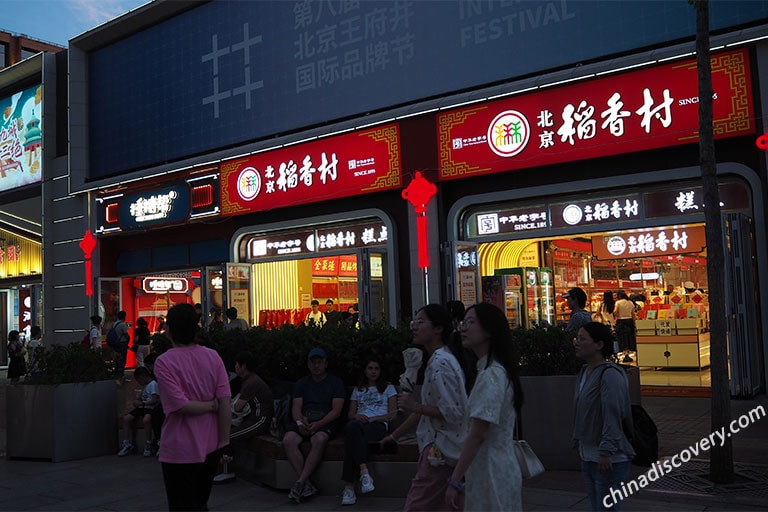
Wangfujing Food Street
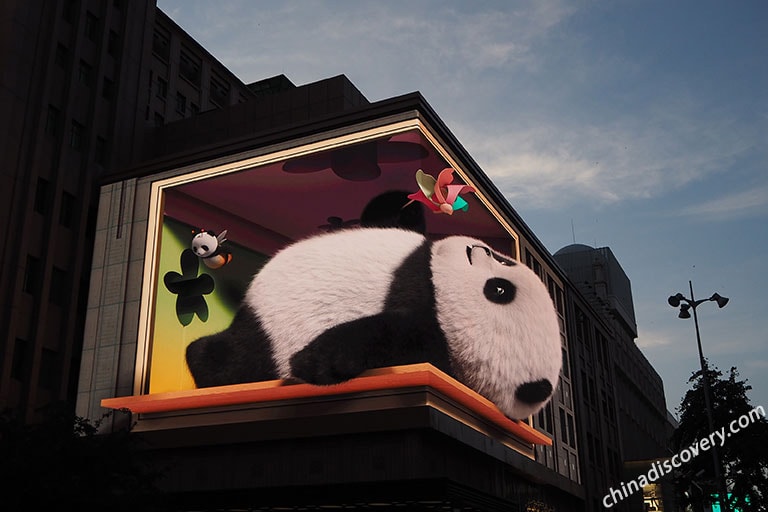
Wangfujing Food Street
Chinese Food Culture
Nourished by the five thousand years’ history and multiple nations and regions in the vast land, China’s food culture is more than what words can describe. Rooted in traditional Chinese philosophy, like Yin-Yang and Five Element and Confucianism, Chinese cuisine is beyond the food itself but an artwork of the creative minds. Under the guidance of Traditional Chinese Medicine, most of the Chinese cuisines are healthy and nutritious, pursuing to maintain people’s health, and even help the patients get healed.
Are you wondering about Chinese cooking process? Is that hard? around 100 cooking techniques have been formed over the development of Chinese food culture. The diverse cooking techniques show the wisdom of Chinese people and also help a lot on the sustainable development and reformation of the Chinese cuisines.
To enjoy the authentic Chinese flavour in a right way, Chinese dining etiquette plays a rather important role in Chinese food culture. Getting to know the Chinese etiquette will not only show one’s good self-cultivation and manners, but also help your understand the culture deeply and avoid making taboos accidentally to behave offensively to your Chinese host.
Start planning your tailor-made holiday to China by contacting one of our specialists. Once inquired, you’ll get a response within 0.5~23.5 hours.
Customize a TripHave a question? Get answers from our travel experts or guests
- Your Question:
- Your Name:
- Your Email:
- Submit

























